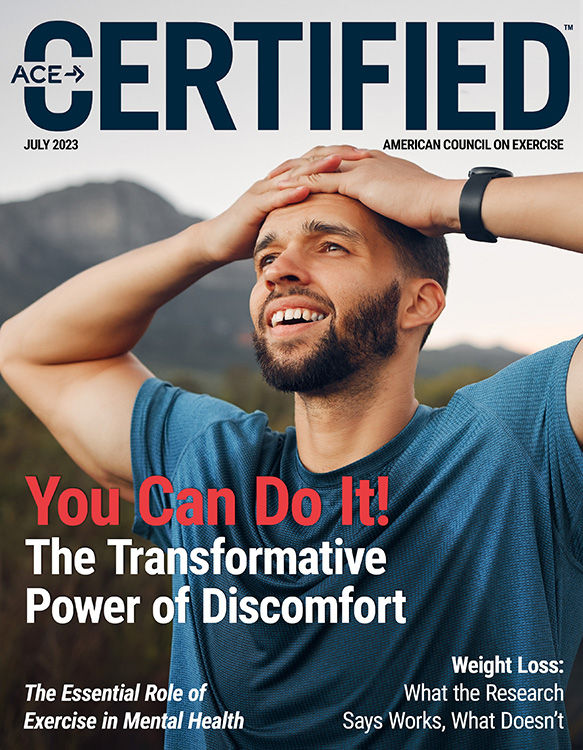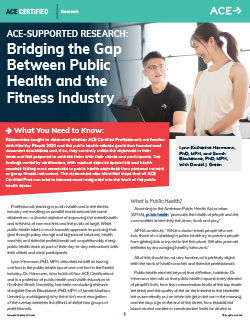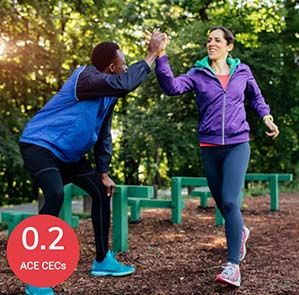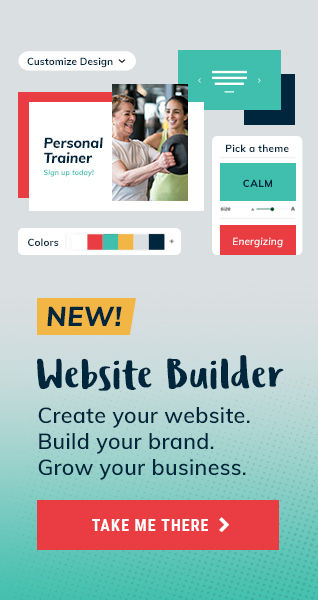ACE-SUPPORTED RESEARCH: Bridging the Gap Between Public Health and the Fitness Industry

What You Need to Know
Researchers sought to determine whether ACE Certified Professionals are familiar with Healthy People 2030 and the public health–related goals that foundational document establishes and, if so, if they currently utilize the objectives in their work and feel prepared to address them with their clients and participants. The findings varied by certification, with medical exercise specialists and health coaches feeling more connected to public health objectives than personal trainers or group fitness instructors. The researchers also identified steps that all ACE Certified Pros can take to become more integrated into the work of the public health sector.
Professionals working in public health and in the fitness industry are traveling on parallel tracks toward the same destination—a shared objective of improving the overall health and wellness of communities and the public at large. While public health takes a much broader approach to pursuing that goal through policy change and big-picture solutions, health coaches and exercise professionals are unquestionably doing public health work as part of their day-to-day interactions with their clients and class participants.
Lynn Herrmann, PhD, MPH, describes herself as having one foot in the public health space and one foot in the fitness industry. Dr. Herrmann, who holds all four ACE Certifications and is a professor of public health and health education at Northern Illinois University, has been conducting research alongside Sarah Blackstone, PhD, MPH, of James Madison University, investigating why there isn’t more recognition of the overlap between the efforts of these two groups of professionals.
What Is Public Health?
According to the American Public Health Association (APHA), public health “promotes the health of people and the communities where they live, learn, work and play.”
APHA continues: “While a doctor treats people who are sick, those of us working in public health try to prevent people from getting sick or injured in the first place. We also promote wellness by encouraging healthy behaviors.”
All of this should sound very familiar, as it perfectly aligns with the work of health coaches and exercise professionals.
Public health reaches beyond that definition, however. Dr. Herrmann reminds us that public health impacts every element of people’s lives, from the contamination levels of the tap water we drink and the quality of the air we breathe to the seatbelts we automatically put on when we get in the car in the morning and the stop sign at the end of the street, from established blood alcohol content or concentration limits for drivers to laws defining where and when people can smoke cigarettes. All these things, which are so entrenched that most of us take them for granted as we move through our days, are the result of effective public health initiatives and policies.
So, stated more simply, public health involves everything that is in place to help people live healthier lives. Dr. Herrmann’s hope is that this type of research will enlighten more ACE Certified Professionals to the fact that they are doing public health work and empower them to become more educated on how they can increase their efforts in this area.
Healthy People 2030
Every 10 years, through a joint effort among several United States federal government offices, a new set of objectives are released with the intention of guiding and measuring changes in health behaviors among the U.S. population. The latest edition, Healthy People 2030, was published in 2020 and “sets data-driven national objectives to improve health and well-being” by 2030.
Those objectives are divided into five categories: health conditions (e.g., diabetes, overweight and obesity, arthritis, cancer, infectious disease), health behaviors (e.g., physical activity, sleep, tobacco use), populations (e.g., adolescents, children, workforce, older adults), settings and systems (e.g., healthcare, schools, environmental health), and social determinants of health (e.g., neighborhood and built environment, healthcare access and quality). In total, this document outlines 358 measurable objectives, as well as additional developmental and research objectives.
“In the public health world,” explains Dr. Herrmann, “Healthy People 2030 is the gold standard for what we want to achieve.”
The Study
With such clear standards set at the federal government level, a question arises regarding whether professionals, be it in healthcare, public health or other sectors, (1) are familiar with the objectives, (2) currently utilize the objectives and (3) feel prepared to address these objectives.
With support from the American Council on Exercise, Drs. Herrmann and Blackstone conducted a survey to gauge whether ACE Certified Health Coaches and Exercise Professionals can confidently answer yes to any of those three questions.
ACE Certified Professionals are perfectly positioned to impact our collective ability to meet the physical-activity objectives, along with the related health behavior and health condition objectives outlined in Healthy People 2030, as part of the collaborative multisector approach that is vital to the success of the public health initiative.
This study focused on six general physical-activity goals:
- Reduce the proportion of adults who do no physical activity in their free time
- Increase the proportion of adults who do enough aerobic physical activity for substantial health benefits
- Increase the proportion of adults who do enough aerobic physical activity for extensive health benefits
- Increase the proportion of adults who do enough muscle-strengthening activity
- Increase the proportion of adults who do enough aerobic and muscle-strengthening activity
- Increase the proportion of adults who walk or bike to get places
- The researchers surveyed 1,644 ACE Certified Professionals, first asking them about their familiarity with, and utilization of, Healthy People 2030 as a general concept, with answers ranging from “not at all familiar” to “extremely familiar” and from “never” to “a great deal,” respectively.
Study participants were also asked about how prepared they felt to address each of the six goals listed above, on a range from “not at all prepared” to “completely prepared.”
The demographics of the study participants are presented in Table 1.

The Results
The graphs presented in Figure 1 summarize the findings in terms of how empowered the survey participants felt to address each objective in their work as a health coach or exercise professional.
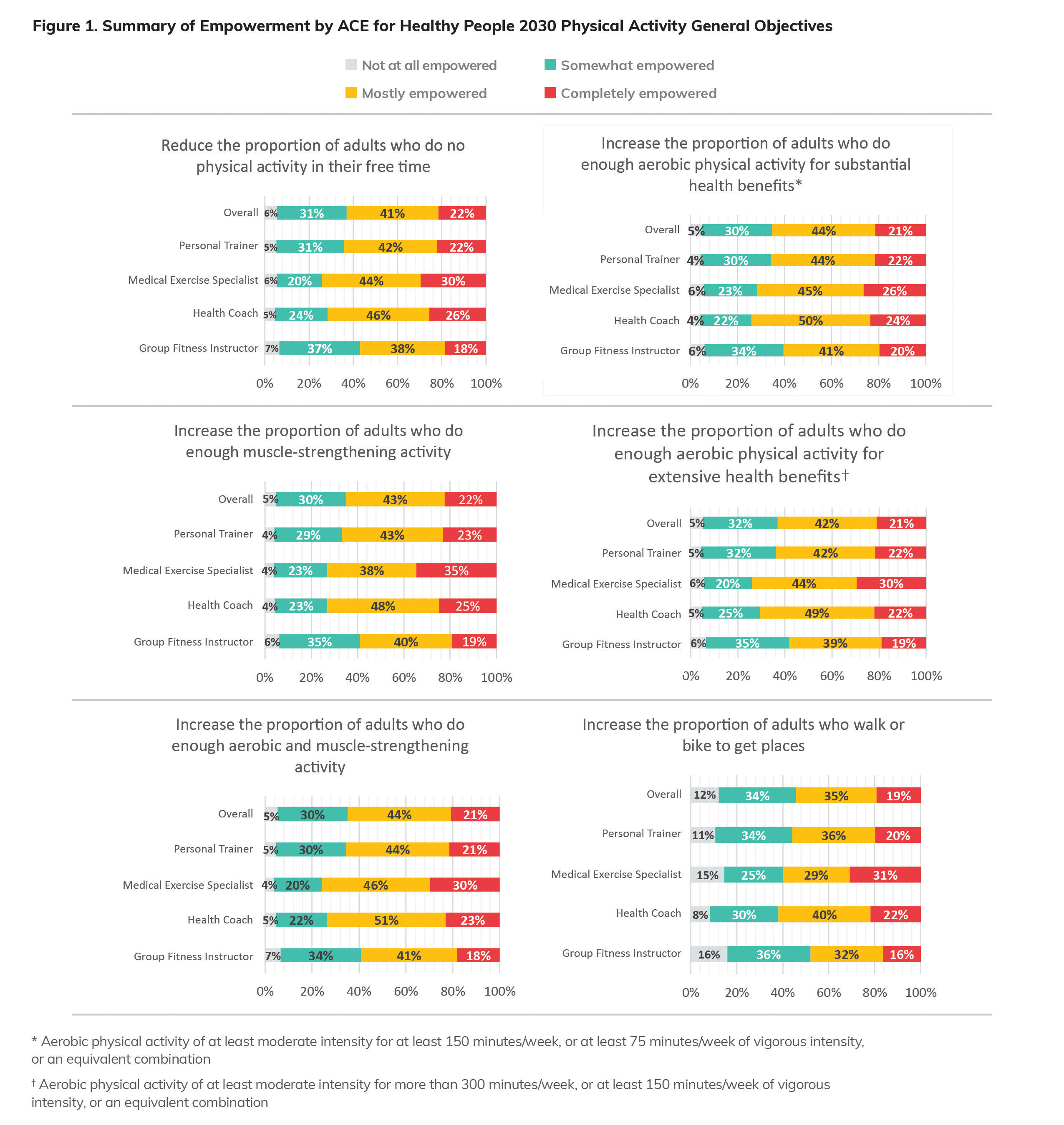
As you can see, the responses across all six questions are consistent, with ACE Certified Medical Exercise Specialists and Health Coaches feeling more empowered than Personal Trainers and Group Fitness Instructors to impact the health behaviors of their clients and participants.
This makes intuitive sense. Medical Exercise Specialists must complete 500 hundred hours of work experience and have at least a bachelor’s degree in exercise science or a related field before they are even allowed to sit for the exam. These requirements mean that these professionals have a more in-depth education, have been exposed to variety of health-related situations and have experience collaborating as part of a team.
Health Coaches, meanwhile, spend more time studying public health–related content, such as the social determinants of health, than Personal Trainers and Group Fitness Instructors might. In addition, the work of a Health Coach extends beyond exercise and focuses more on health behavior change.
One important thing to note here is that the Certification section of Table 1 shows that many of the survey respondents held multiple ACE Certifications. A deeper dive into this issue reveals that individuals holding more than one certification felt more empowered to help their clients and participants meet the Healthy People 2030 objectives, particularly if that included the Medical Exercise Specialist and/or Health Coach Certification.
The Bottom Line
For health coaches and exercise professionals, step 1 of becoming part of the public health discussion is recognizing your role in making an impact that extends beyond the classes you teach or the sessions you lead. While the findings of the survey may not have been all that surprising, there was one thing that Dr. Herrmann wanted to highlight: “What surprised me,” she says, “was that group fitness instructors didn’t see their work as public health, because they’re literally in a group public setting teaching concepts and educating people. A lot of group fitness instructors are doing health promotion.”
“I want group fitness instructors to recognize that what they’re doing is public health work and have that be a springboard or a point of empowerment for them,” says Dr. Herrmann.
The same can be said of personal trainers, health coaches and medical exercise specialists—they are actively engaged in public health work, but simply don’t see themselves that way.
Step 2 involves educating yourself about public health and the role you can play not only in terms of the six objectives covered by this research, but also when it comes to health conditions you might specialize in or health behaviors you may focus on addressing. Reviewing Healthy People 2030 is a great place to start.
In addition, Dr. Herrmann developed a continuing education course entitled Practical Public Health for Exercise Professional and Health Coaches, which covers the relationship between the work of exercise professionals and health coaches and the work of public health, as well as how you can apply public health concepts to your day-to-day work.
Finally, step 3 involves actually contributing to public health. Dr. Herrmann explains that once you understand that the work you do impacts public health, you can start looking at clients and participants through that new lens.
The goal is to provide more health education and health promotion. Hopefully, your clients or participants will then share that information with their friends and family members, which is when the work of a health coach or exercise professional extends out into the local community and beyond.
Ultimately, what Dr. Herrmann says she would love to see is health coaches and exercise professionals getting more involved in the policy elements of public health. You are the ones who have your boots on the ground every day and truly understand the needs of your clients and participants and, by extension, of the general public.
Collectively, the fitness industry and the public health sector can have a bigger impact on the health and wellness of the population as a whole if we work together toward our overlapping goals and start traveling on a shared road rather than on parallel tracks.
Expand Your Knowledge
Practical Public Health for Exercise Professionals and Health Coaches
In recent years, the health and fitness industry has been connecting their work to public health in unique ways, such as ACE’s Moving Together Outside Campaign, and influencing health policies around active communities and workplace wellness. As a health and exercise professional, you may be excited for the opportunity to make an impact on our nation’s health with a public health focus, but you may not have a public health background or a strong grasp of exactly what defines public health.
In this course, you will gain an understanding of several commonly used public health concepts, and how they can directly relate to the work of exercise professionals and health coaches like you. By gaining a greater perspective on how the systems in place around us affect our health behaviors and outcomes, exercise professionals and health coaches like you will be better able to cultivate positive behavior change at the individual level, while also creating change at the community level and beyond through collaborations.
Developed by Lynn Katherine Herrmann, PhD, MPH, and ACE Certified Health Coach, Personal Trainer, Group Fitness Instructor, and Medical Exercise Specialist, this course is designed to empower exercise professionals and health coaches to grow in their career through a better understanding of how health behaviors relate to the world around us, and how we can interact with clients and participants in a meaningful way that drives lasting change and improved health for everyone.
